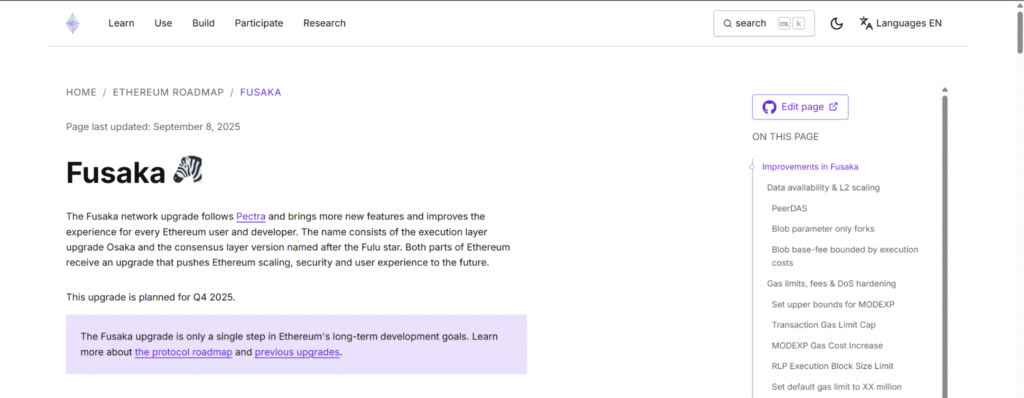Ethereum’s developers have set their sights on November 2025 for the Fusaka upgrade, a major step that aims to strengthen scalability, efficiency, and user experience across the network.
This proposed date comes after months of work on test networks where developers have trialled features, discovered technical issues, and refined their approaches.
Although some challenges remain, the level of progress so far has given teams the confidence to outline a roadmap for release in the final quarter of the year. For users, there will be no direct action required, yet the upgrade will transform how Ethereum operates behind the scenes.
The Roadmap Towards Fusaka
The timeline for Fusaka was presented during the 220th Ethereum Execution Layer Core Developers meeting, where Christine Kim of Galaxy shared a summary of the discussions.
Developers have been steadily advancing through a sequence of test networks known as devnets. Each devnet allows client teams to experiment with features in a controlled environment and identify any weaknesses before rolling them out more broadly.
Recent testing on Devnet 3 focused on non-finality scenarios, where the network was deliberately stressed to see how it handled potential failures. While this stage surfaced technical defects, it also confirmed that the systems in place can be refined to achieve stability.
The next stage will be Devnet 5, which is designed to trial a blob parameter-only fork. Blobs are a new form of temporary data storage used by Layer 2 networks when they post data back to Ethereum.
The ability to adjust blob parameters without waiting for full upgrades is essential for flexibility as Layer 2 adoption grows.
By isolating this in a smaller fork, developers can test the impact of scaling blob numbers without delaying the entire roadmap. This step reflects the practical approach Ethereum teams are taking, combining caution with the need to adapt quickly.
Fusaka does not exist in isolation. It follows upgrades such as Dencun, which introduced blob transactions for Layer 2 networks, and Pectra, which improved efficiency and staking design.
These earlier milestones laid the foundation that makes Fusaka possible. The sequence highlights how Ethereum development is gradual, with each stage building on previous work rather than attempting to deliver every change at once.
This method reduces risks and ensures the network remains reliable. If Devnet 5 and subsequent tests prove successful, client teams will prepare their software for a coordinated mainnet release in the last quarter of 2025. The roadmap also acknowledges that the timeline remains a target rather than a guarantee.
Ethereum upgrades must achieve consensus across thousands of independent nodes, all running different client software. Any defect or performance issue discovered during testing could delay the final date.
Developers, therefore, balance optimism with caution, ensuring that network stability remains the first priority. For now, the November 2025 target signals confidence but remains dependent on upcoming results.
What the Fusaka Upgrade Will Bring
The Fusaka upgrade combines improvements across both the execution layer and the consensus layer, meaning it affects how transactions are processed as well as how blocks are proposed and validated.

The most important feature is PeerDAS, which stands for Peer Data Availability Sampling. Under current conditions, every Ethereum node must download all blob data from Layer 2 networks, a requirement that becomes increasingly burdensome as usage grows.
PeerDAS changes this by distributing blob data across the network so that each node is only responsible for a small portion.
This reduces the resource requirements of running a node while still ensuring that data can always be reconstructed from the network as a whole. The result is better scalability for Layer 2 networks and lower costs for users.
Another central feature is the introduction of blob parameter only forks. These allow the number of blobs to be adjusted between major upgrades. As Layer 2 networks expand, the need for more blobs will rise.
Instead of waiting years for a scheduled upgrade, developers and client teams can agree to raise blob counts in smaller coordinated steps. This flexibility ensures that Ethereum can respond to demand promptly without placing unnecessary strain on the system.
Fusaka also introduces new rules for gas fees that improve fairness and security. One example is EIP 7918, which ensures that Layer 2 networks always pay a meaningful minimum cost when posting data.
Without this safeguard, blob fees could collapse to almost nothing, undermining their role as a price signal. By tying blob fees more closely to the computation they require, Fusaka protects the network against abuse while keeping costs predictable.
At the same time, caps on transaction gas usage and new pricing for specific functions such as modular exponentiation reduce the risk of denial of service attacks. These changes ensure that as Ethereum scales, it remains safe from attacks that could overload nodes with excessive work.
Beyond scaling and security, Fusaka also introduces features designed to improve user experience. One of the most notable is native support for secp256r1, a cryptographic curve used in passkeys and device authentication.
This allows wallets to integrate directly with secure hardware modules on phones and computers, enabling logins without seed phrases and more familiar recovery options.
For users, this means Ethereum applications can offer experiences closer to modern mobile and web apps while still maintaining decentralised security. Developers also benefit from simpler coding as the function is provided natively.
Other smaller but useful features include new opcodes such as Count Leading Zeros, which streamline common programming tasks, and support for preconfirmation through deterministic proposer lookahead, which allows users to receive commitments that their transaction will be included in upcoming blocks.
These improvements may not be immediately visible to users, but they lay the foundation for a more reliable and efficient ecosystem.
When viewed together, the changes in Fusaka represent a careful balance. On one side, the network must scale to handle more activity as Layer 2 adoption rises.
On the other, it must protect security, ensure fair costs, and maintain reliability for node operators. By addressing these factors simultaneously, Fusaka strengthens Ethereum’s ability to serve as a global settlement layer for decentralised applications.
Conclusion
The Fusaka upgrade represents a major milestone in Ethereum’s journey. It combines scaling features, security improvements, and user-focused enhancements in a single release. For developers, it unlocks tools that make applications more efficient and easier to build.
For users, it lowers costs on Layer 2 networks and improves the overall experience without requiring any action.
The planned timeline of November 2025 reflects optimism from the developer community, but final delivery will depend on the outcome of ongoing tests.
Regardless of timing, Fusaka demonstrates Ethereum’s steady progress toward a network capable of supporting global adoption with efficiency, security, and accessibility.

